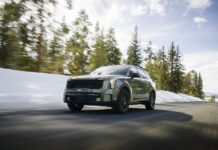ANN ARBOR, Michigan, Aug. 2, 2017 /PRNewswire-HISPANIC PR WIRE/ — Toyota’s Collaborative Safety Research Center (CSRC) today announced a sweeping set of new research programs studying the opportunities and addressing the challenges of emerging vehicle technologies. The eleven projects, launched in partnership with eight leading research institutions in North America, mark the first projects launched under CSRC Next, the Center’s new five-year program that continues to support a safer transition to the future of mobility.

The research projects will focus on the impact of advanced technology on broader road safety trends and the interaction between humans and machines. Specific research challenges include the integration of advanced active safety systems, like automatic emergency braking, and passive systems, human experience design for advanced technology vehicles, driver state detection, and using analytics to help improve the study of naturalistic driving data.
“Autonomous and connected vehicle technologies are only just beginning to transform the transportation landscape,” said Chuck Gulash, Director of CSRC. “By working together with world-renowned institutions and making our results public, we are proud to help realize the promise of advanced mobility solutions and a safe, convenient transportation future.”
Since its launch in 2011, CSRC has launched and completed 44 research projects with 23 partner universities, publishing more than 200 papers and presenting at multiple industry conferences. CSRC projects have made meaningful contributions to auto safety industrywide, including research into human factors on vehicle safety and the efficacy of active and passive safety systems, as well as the collection of driving data and development of new tools to analyze that data.
Launched in January 2017, CSRC Next builds upon the insights gained from the CSRC’s first five years and will direct $35 million towards safety research into advanced vehicle technologies, including both autonomous and connected systems. CSRC Next will continue to support ongoing research programs at the Toyota Research Institute (TRI) and Toyota Connected (TC) to help accelerate the development of autonomous and connected driving technologies and services.
CSRC projects will follow four research tracks:
- The potential integration of advanced active safety systems and passive safety systems, using advanced pre-crash sensors to improve and personalize crash protection;
- Building research models to help understand and strengthen the driver-vehicle relationship, and to support the social acceptance of advanced vehicle technologies;
- Studying driver state detection, working to improve mobility using metrics for physiology and health;
- Applying big data and safety analytics techniques to develop algorithms and tools to study naturalistic driving data.
The full list of new CSRC Next research projects and partners includes:
|
Project Title |
Description |
Partner |
|
Motion and Muscle Activation of Young Volunteers in Evasive Vehicle Maneuvers |
Quantify key occupant responses (kinematics and muscle activity) to evasive swerving and emergency braking using both adult and child subjects on a test track. |
Children’s Hospital of Philadelphia |
|
Integrated Benefit Estimation for Comprehensive Active / Passive Systems |
Estimate the Residual Safety Problem after Integrated Safety Systems (ISS) is deployed in the future. ISS consists of all active (auto braking for vehicle, pedestrian, bicyclist, lane keeping, etc.) and passive safety systems (advanced airbag, curtain shield airbag, roof strength, pedestrian protection active hood, etc.). |
Virginia Tech |
|
Vehicle Occupant Dynamics During Crash Avoidance Maneuvers |
Investigate kinematics of minimally aware adult occupants exposed to Automatic Emergency Braking (AEB) and evasive maneuvers on a test track. |
University of Michigan Transportation Research Institute |
|
Study for Developing an In-Vehicle Emergency Medical Condition Detection System |
Develop a computational technique for noise tolerant robust detection and prediction of Myocardial Infarction and Myocardial Ischemia (MI) inside a vehicle. Machine learning models will be trained with ECG data collected from in-hospital and in-vehicle subjects to help detect and predict the in-vehicle occurrence of MI as well as other related severe cardiac arrests. |
University of Michigan Center for Integrative Research in Critical Care (MCIRCC) |
|
Adaptive Headlamp System Benefit Estimation |
Measure the response characteristics and estimated benefit with respect to reduction in injury/fatalities of adaptive headlamp system that highlights detected pedestrians and bicyclists using both driver and pedestrian/bicycle simulator study. |
University of Iowa – National Advanced Driving Simulator |
|
Naturalistic and Controlled Driving Studies – Transitions in Automated Driving |
Provide a meaningful and useful dataset of driver behaviors when encountering situations where transfer of control between automation and the human is required. |
University of Iowa – National Advanced Driving Simulator |
|
Road Departure Test Method Development |
Develop test scenarios and methods for the evaluation of vehicle road departure warning, assist and control systems on a test track. |
Indiana University-Purdue University Indianapolis, Transportation Active Safety Institute (TASI) |
|
Analysis of Communication Between Drivers – The Language of Driving |
Identify what kind of communication we have with other road users (e.g., pedestrians, other vehicles) with cutting-edge technology of computer vision. |
Massachusetts Institute of Technology Age Lab |
|
Surrounding Environment Recognition Technology and Evaluation Metrics |
Develop a deep learning based full-scene recognition of vehicle environment from a vision sensor. Examples are vehicles, pedestrians, bicyclists, traffic signs, buildings, curbs, etc. |
Massachusetts Institute of Technology Age Lab |
|
Theory of Communication Between Drivers – Enhancing Social Interaction |
Provide theoretical and mathematical framework of how drivers communicate at an intersection. |
University of Wisconsin |
|
Human Centered Automated Driving in the Real World: Holistic Perception and Performance Metrics |
Provide a computational prediction model for a transfer of control between the automation and the human driver. The model has factors originated from human motor and perceptual behaviors as well as from scenarios and environments. |
University of California, San Diego |
Media Contacts:
TMNA Corporate Communications
Brian Lyons
469-292-3573
[email protected]
Ming-Jou Chen
469-292-3799
[email protected]
About Toyota
Toyota (NYSE:TM) has been a part of the cultural fabric in the U.S. and North America for 60 years, and is committed to advancing sustainable, next-generation mobility through our Toyota and Lexus brands. During that time, Toyota has created a tremendous value chain as our teams have contributed to world-class design, engineering, and assembly of more than 33 million cars and trucks in North America, where we operate 14 manufacturing plants (10 in the U.S.) and directly employ more than 46,000 people (more than 36,000 in the U.S.). Our 1,800 North American dealerships (nearly 1,500 in the U.S.) sold almost 2.7 million cars and trucks (2.45 million in the U.S.) in 2016 – and about 85 percent of all Toyota vehicles sold over the past 15 years are still on the road today.
Toyota partners with community, civic, academic, and governmental organizations to address our society’s most pressing mobility challenges. We share company resources and extensive know-how to support non-profits to help expand their ability to assist more people move more places. For more information about Toyota, visit www.toyotanewsroom.com.
Logo: http://mma.prnewswire.com/media/439685/Toyota_Corp_Red_Logo.jpg
SOURCE Toyota Motor North America







